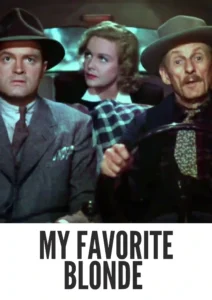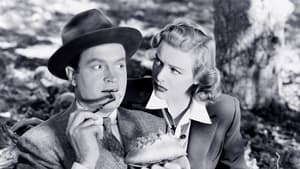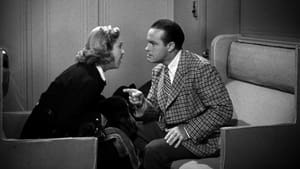Contact: info@alwanfilm.com
Video Sources 0 Views

My Favorite Blonde 1942 Colorized
Synopsis
Review: My Favorite Blonde 1942 Colorized – A Classic Comedy Thriller Revisited

Introduction
In the annals of classic Hollywood cinema, few films encapsulate the charm and wit of the era quite like “My Favorite Blonde” (1942). Starring Bob Hope and Madeleine Carroll, this film blends comedy, romance, and espionage into a delightful cinematic experience. With its recent digital restoration, “My Favorite Blonde” has garnered renewed interest and praise. In this article, we delve into the film’s captivating story, memorable performances, and the lasting legacy of this 1940s gem.
Check The Full Colorized Movies List
Check Our Colorized Movies Trailer Channel
Understanding My Favorite Blonde 1942 Colorized: Director, Cast, and Genre
“My Favorite Blonde” is directed by Sidney Lanfield, a filmmaker known for his adept handling of comedy and light-hearted adventure. Lanfield’s direction in this film showcases his ability to balance humor with thrilling elements, creating a seamless blend of genres.
The film stars Bob Hope as Larry Haines, a hapless vaudeville performer who becomes entangled in a web of international intrigue. Madeleine Carroll plays Karen Bentley, a British secret agent on a mission. Together, they form a dynamic duo whose chemistry and comedic timing drive the narrative forward.
The film fits comfortably within the comedy-thriller genre, characterized by its witty dialogue, slapstick humor, and suspenseful plot twists. “My Favorite Blonde” exemplifies the best of 1940s Hollywood, offering audiences a perfect blend of laughter and excitement.
Exploring the World of My Favorite Blonde 1942 Colorized: Plot and Characters
“My Favorite Blonde” opens with Larry Haines performing his vaudeville act with Percy, his trained penguin, in tow. Unbeknownst to Larry, his life is about to take a dramatic turn when he crosses paths with Karen Bentley. Karen is on the run from Nazi agents and is carrying a crucial piece of intelligence that could impact the outcome of World War II.
The plot quickly thickens as Larry unwittingly becomes Karen’s unwitting accomplice, forced to flee across the country while dodging a series of comic and dangerous obstacles. Along the way, their relationship evolves from mere survival partners to a romantic duo, adding a touch of heartfelt connection amidst the chaos.
The supporting characters, including the bumbling Nazi agents and Larry’s vaudeville colleagues, add depth and humor to the story. Each character is well-drawn and contributes to the film’s lively and engaging narrative.
The Art of Film Restoration
The restoration of classic films is an essential aspect of preserving cinematic history for future generations. “My Favorite Blonde” has undergone a meticulous digital restoration process, breathing new life into its visuals and sound.
Film restoration involves repairing damaged frames, enhancing audio quality, and sometimes even colorizing black-and-white footage. In the case of “My Favorite Blonde,” the focus was on maintaining the film’s original charm while improving its overall quality for modern audiences. The result is a crisp, vibrant version of the film that retains its classic appeal.
Early Comedy Thrillers: A Brief History
The comedy-thriller genre has a rich history in Hollywood, dating back to the silent film era. Filmmakers have long recognized the entertainment value of combining humor with suspense, creating a dynamic and engaging viewing experience.
In the 1930s and 1940s, the genre gained popularity with films like “The Thin Man” series and Alfred Hitchcock’s “The Lady Vanishes.” These films set the stage for the comedic yet thrilling narrative style that “My Favorite Blonde” exemplifies. The blending of genres allowed filmmakers to explore complex storylines while keeping audiences entertained with humor and wit.
My Favorite Blonde 1942 and Its Digital Restoration
The decision to restore “My Favorite Blonde” digitally underscores the film’s enduring popularity and cultural significance. By enhancing the visual and auditory elements, the restoration allows contemporary audiences to appreciate the film’s original artistry.
The restored version of “My Favorite Blonde” reveals details that may have been overlooked in earlier prints, such as the nuances of the actors’ performances and the intricacies of the set design. This restoration not only preserves the film for posterity but also provides a richer, more immersive viewing experience.
The Debate Over Film Restoration
As with any form of artistic preservation, film restoration sparks debates among cinephiles and scholars. Some argue that restoration can alter the original aesthetic of a film, potentially compromising the director’s vision. Others believe that restoration is essential for maintaining the cultural and historical value of classic films.
In the case of “My Favorite Blonde,” the restoration process aimed to strike a balance between preserving the film’s original qualities and making it accessible to modern audiences. By enhancing the film’s technical aspects without altering its core essence, the restoration respects both the historical integrity and contemporary appeal of the film.
Examining My Favorite Blonde 1942 as a Restored Classic
Viewing “My Favorite Blonde” in its restored form offers a unique opportunity to appreciate the film’s craftsmanship and timeless appeal. The restoration highlights the film’s sharp wit, engaging performances, and clever direction, allowing it to shine as a classic comedy thriller.
Bob Hope’s comedic genius is on full display, with his impeccable timing and charming persona adding layers of humor to the film. Madeleine Carroll’s portrayal of Karen Bentley brings a touch of sophistication and intrigue, creating a perfect foil for Hope’s character. Together, they navigate the film’s twists and turns with a blend of humor and heart.
Influence and Legacy: My Favorite Blonde 1942 Colorized’s Impact on Cinema
“My Favorite Blonde” has left an indelible mark on the comedy-thriller genre, influencing countless films and television shows. Its successful blend of humor, romance, and suspense set a template for future productions, demonstrating the enduring appeal of such narratives.
The film’s impact extends beyond its genre, showcasing the versatility of its stars and the creative prowess of its director. Bob Hope’s performance in “My Favorite Blonde” solidified his status as a leading comedic actor, paving the way for his future successes in film and television.
Director’s Cinematic Legacy: Beyond My Favorite Blonde 1942 Colorized
Sidney Lanfield’s career is marked by a series of successful films that span various genres, from comedy to drama. His ability to navigate different narrative styles and his keen eye for comedic timing have earned him a place among Hollywood’s notable directors.
Beyond “My Favorite Blonde,” Lanfield’s filmography includes classics like “The Hound of the Baskervilles” (1939) and “The Lemon Drop Kid” (1951). His work has influenced generations of filmmakers, contributing to the evolution of Hollywood cinema.
Themes Explored in My Favorite Blonde 1942 Colorized
“My Favorite Blonde” explores themes of identity, deception, and the resilience of the human spirit. Through the comedic lens, the film delves into serious issues such as wartime espionage and the fight against tyranny, offering a poignant commentary on the era’s social and political climate.
The film’s humor serves as a vehicle for exploring deeper themes, allowing audiences to engage with serious subjects while enjoying the light-hearted narrative. This balance of comedy and drama is a testament to the film’s enduring appeal and its relevance in contemporary discussions.
Reception and Controversy Surrounding My Favorite Blonde 1942 Colorized
Upon its release, “My Favorite Blonde” was met with critical acclaim and commercial success. Audiences and critics praised the film’s engaging storyline, witty dialogue, and standout performances. Bob Hope’s comedic talent and Madeleine Carroll’s charm garnered particular acclaim, cementing their status as Hollywood stars.
In recent years, the digital restoration of “My Favorite Blonde” has reignited interest in the film, drawing attention to its historical and cultural significance. While some purists may argue against the alteration of classic films, the restoration has been largely welcomed as a means of preserving and celebrating the film’s legacy.
Where to Watch My Favorite Blonde 1942 Colorized Online
For those eager to experience the timeless brilliance of “My Favorite Blonde,” the film is available on various streaming platforms. The restored version offers a high-quality viewing experience, ensuring that audiences can appreciate the film’s charm and wit in all its glory.
Popular streaming services like Amazon Prime Video, Apple iTunes, and Criterion Channel offer “My Favorite Blonde” as part of their classic film collections. These platforms provide easy access to the film, allowing new generations to discover and enjoy this 1942 gem.
FAQs About My Favorite Blonde 1942 Colorized
Common queries surrounding “My Favorite Blonde” include questions about its historical context, restoration process, and thematic elements. Addressing these frequently asked questions can enhance viewers’ understanding and appreciation of the film.
Q: What inspired the plot of “My Favorite Blonde”?
A: “My Favorite Blonde” draws inspiration from the espionage thrillers and screwball comedies popular in the early 1940s. The film’s blend of humor and suspense reflects the era’s cinematic trends, offering a unique take on the genre.
Q: How does the digital restoration process work?
A: Digital restoration involves scanning the original film negatives at a high resolution, followed by meticulous frame-by-frame repair of any damage or imperfections. Audio enhancements and color correction are also part of the process, ensuring the restored film retains its original charm while meeting modern technical standards.
Q: What themes are explored in “My Favorite Blonde”?
A: The film explores themes of identity, deception, and resilience, using humor as a vehicle for addressing serious issues such as wartime espionage and the fight against tyranny. These themes add depth to the film’s light-hearted narrative, making it relevant to contemporary audiences.
Conclusion
In conclusion, “My Favorite Blonde” stands as a testament to the enduring power of classic Hollywood cinema. Its blend of comedy, romance, and espionage, coupled with memorable performances and sharp direction, ensures its place in the pantheon of beloved films. The recent digital restoration of “My Favorite Blonde” offers a fresh opportunity for audiences to experience the film in all its restored glory, preserving its legacy for future generations.
As we celebrate the timeless appeal of “My Favorite Blonde,” let us recognize the importance of preserving and honoring the rich history of cinema. In doing so, we ensure that the magic of films like “My Favorite Blonde” continues to inspire and delight audiences for years to come.













